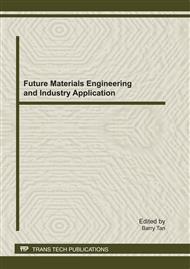[1]
L. Guize,B. Pannier,F. Thomas,K. Bean,B. Jégo and A. Benetos. Recent advances in metabolic syndrome and cardiovascular disease, Archives of Cardiovascular Diseases, Vol. 101, 2008, pp.577-583.
DOI: 10.1016/j.acvd.2008.06.011
Google Scholar
[2]
C.N. Lattanzio and R. J. Petrella. The prevalence of hypertension and metabolic clustering (hyperlipidemia and hyperinsulinemia) in healthy older adults, American Journal of Hypertension, vol. 13, 2000, p.101.
DOI: 10.1016/s0895-7061(00)00509-4
Google Scholar
[3]
R.L. Yang, G. w. Le, A.L. Li, J.L. Zheng and Y.H. Shi. Effect of antioxidant capacity on blood lipid metabolism and lipoprotein lipase activity of rats fed a high-fat diet, Nutrition, vol. 22, 2006, pp.1185-1191.
DOI: 10.1016/j.nut.2006.08.018
Google Scholar
[4]
D.K. O'Toole. Soy-Based Fermented Foods, Encyclopedia of Grain Science, 2004, pp.174-185.
Google Scholar
[5]
Y.W. Tsang, K.H. Chi, C.J. Hu ,C.T. Tseng , F.W. Tseng and Y.S. Wang. Chemotherapy-inducd immunosuppression is restored by a fermented soybean extract: a proof of concept clinical trial, Nutrition Research, vol. 27, 2007, pp.679-684.
DOI: 10.1016/j.nutres.2007.09.001
Google Scholar
[6]
B. Yu , Z.X. Lu , X.B. Bie , F.X. Lu and X.Q. Huang. Optimisation of the medium composition for production of protease and soybean peptides by Bacillus subtilis SHZ using response surface methodology. Internationa, Journal of Food Science and Technology, vol. 43, 2008, p.1143.
DOI: 10.1111/j.1365-2621.2007.01580.x
Google Scholar
[7]
B. Yu , Z.X. Lu , X.B. Bie , F.X. Lu and X.Q. Huang. Scavenging and anti-fatigue activity of fermented defatted soybean peptides, Europe Food Research Technology, vol. 226, 2008, p.415–421.
DOI: 10.1007/s00217-006-0552-1
Google Scholar
[8]
D. D. Kitts and K. Weiler. Bioactive proteins and peptides from food sources, Current Pharmaceutical Design, vol. 9, 2003, p.1309–1323.
DOI: 10.2174/1381612033454883
Google Scholar
[9]
H. Korhonen and A. Pihlanto. Bioactive peptides: Production and functionality, International Dairy Journal vol. 16, 2006, p.945–960.
DOI: 10.1016/j.idairyj.2005.10.012
Google Scholar
[10]
B. Halliwell and J.M.C. Gutteridge. The definition and measurement of antioxidants in biological systems, Free Radical Biology and Medicine, vol. 18, 1999, pp.125-126.
DOI: 10.1016/0891-5849(95)91457-3
Google Scholar
[11]
D.D. Debashis , B. M Bhattacharjee and R.K. Banerjee. Hydroxyl Radical is the MajorCausative Factor in Stress-Induced Gastric Ulceration, Free Radical Biology and Medicine, vol. 23, 1997, pp.8-18.
DOI: 10.1016/s0891-5849(96)00547-3
Google Scholar


